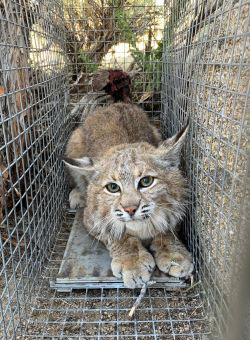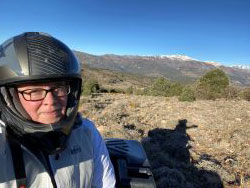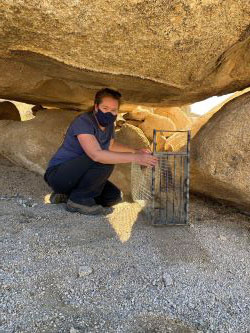Roberts doing camera checks at the Chorro study area in the Central Region

A female bobcat trapped as part of a statewide population study

Roberts checking bobcat traps on an ATV in the Inland Deserts Region

Roberts setting up a bobcat trap at the Fort Irwin study area in the Inland Deserts Region
Senior Environmental Scientist Rachel Roberts oversees CDFW’s statewide project to study the population of bobcats in California. The study will inform management practices and help scientists better understand conflict management issues between bobcats and humans. The research will ultimately culminate in the creation of a statewide bobcat management plan. Roberts was educated at San Jose State University where she earned both an undergraduate degree and a master’s degree in ecology and conservation biology with an emphasis in zoology. In 2011, she volunteered to do habitat restoration work at Pinnacles National Park in Central California. Her volunteer work led to a job as a scientific aide working with condors at the national park. Since that first volunteer position Rachel has worked for the U.S. Forest Service on both the Modoc and the Sierra National Forest, as well as for the California Department of Transportation as an environmental planner. She also worked in the private sector as an independent contractor and at an environmental firm before being hired by CDFW in 2020 as the department’s statewide bobcat research coordinator.
When did you know you wanted a career involving wildlife?
My dad used to take my siblings and me camping all the time, and we spent a lot of time in nature. But the “aha” moment didn’t come to me until later in life. I was a veterinary technician for a long time. I originally thought I wanted to go to veterinary school, but then I realized I wanted to work outside with animals. This was around 2005 and I was still early in my college career. I was trying to figure out what to do next and my now-husband suggested ecology as a major. Once I got into field classes and was learning more about wildlife biology, that was it. I figured out where I wanted to be.
What inspired you to study bobcats?
As a student at San Jose State, we did fieldwork at Cañada de los Osos Ecological Reserve near Gilroy. We’d go out to the reserve on a regular basis, and we’d see bobcats all the time. Bobcats are said to be elusive and shy around humans. They did generally try to avoid us, but I also noticed that they would sit there and watch us while we did fieldwork. They were often as curious about us as we were about them. Seeing so many bobcats on a regular basis is ultimately what led to my master’s thesis. I studied what bobcats were eating at Cañada de los Osos Ecological Reserve and how those prey items were changing seasonally. My love for bobcats has grown as I’ve studied them.
What were bobcats eating at the reserve?
Mostly dusky footed woodrats (Neotoma fuscipes), Botta’s pocket gopher (Thomomys bottae) and California meadow voles (Microtus californicus). Interestingly, they were eating more woodrats in the summer, pocket gophers in the winter and voles in the spring. They were also eating small mammals like field mice and deer mice, and birds like quail, northern flicker, turkeys and jays. At times their diet also included Jerusalem crickets, skunks, hares, snakes and lizards.
What is your job like on a day-to-day basis?
The research project is fairly complex. We have a team of bobcat scientists in each of the six CDFW terrestrial regions across the state collecting data. We have a large grid of camera traps that we are rotating through each of our 48 study areas, and we’re walking 40 kilometers of transects in each study area to collect scat for fecal DNA analysis. We are also deploying GPS collars on bobcats throughout the state. In addition to regional staff, there are multiple leadership groups that help the team make decisions. So my day-to-day involves coordinating the entire effort.
For the first part of the project, I spent a lot of time in the field making sure staff were trained to collect data. I'm currently overseeing the bobcat collaring efforts, but as data collection starts to wind down by the end of June 2022 I’ll be spending more time doing data analysis and writing.
What’s your favorite part of the job?
I could give the obvious answers like working with bobcats and seeing all the great bobcat photos. But beyond that, the team of folks that have been hired to do this research are incredible. My favorite part is working with the young scientists. I’ve been really impressed with their data collection and organizational skills. They’ve been a pleasure to work with and we’re working together to achieve a common goal.
What’s the biggest challenge of your job?
Collecting and organizing data on a statewide scale is very challenging. We have various methods of data collection and management which makes the process easier but ensuring that the data is collected the same way across the state has been a challenge.
What advice do you have for young people who are interested in wildlife careers?
What helped me was all the volunteer work I did. I really wanted as much experience as I could get. I was willing to volunteer, work for little pay, or travel to get that experience. Putting myself in a place to be the person who takes on responsibility was key. I always put my hand up when something needed to be done, and I think that gave me the experience I needed to get here.